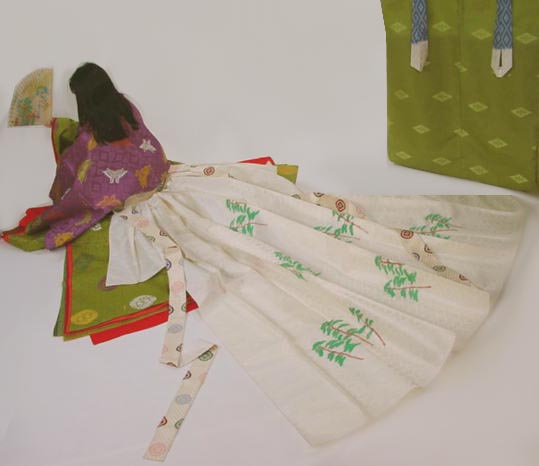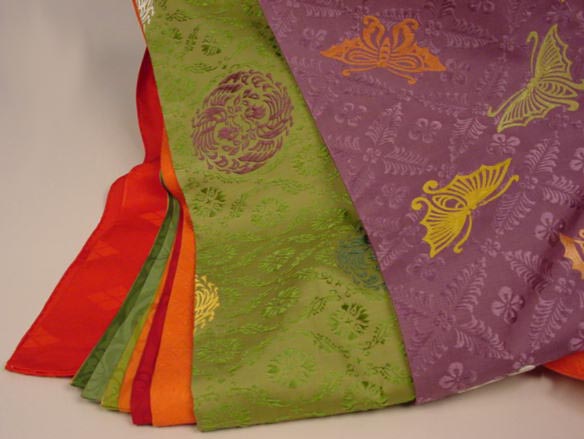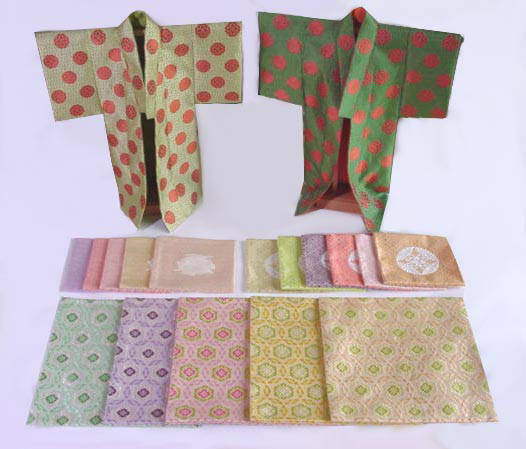NYOUBOUSYOUZOKU (costume for a Courtlady-in-waiting)

The Takata Institute of Japanese Imperial Classical Costume
Formerly at the IMPERIAL HOUSEHOLD of Japan, women had worn a combination of costumes called NYOUBOUSYOUZOKU since around the 11th century (the midlle of the HEIAN ERA of Japan). This was used by the dignitaries of the imperial house. This was a variation of CHOUFUKU in around the 9th century worn by woman-in-waiting at Court.Since the latter half of the 19th century(the MEIJI ERA),it began to be called ITSUTSUGINU, KARAGINU, MO [ITSUTSUGINU(a costume consisiting of five suits of robes to be layered),KARAGINU(an exotic outermost costume),MO(a skirt style of costume with a long train)].Nowadays it is usually called JUUNIHITOE(twelve layers and HITOE),but that is not the proper name.Since modern times it has been used only for the ceremony (an enthronement and a wedding ceremony,and so on)at the IMPERIAL HOUSEHOLD as a costume for a formal occation.NYOUBOUSYOUZOKU consists of KARAGINU, UWAGI, UCHIGINU(glossed robe), ITSUTSUGINU, HITOE, MO, HAKAMA, HIOUGI. KARAGINU means an exotic costume,which was originally a short robe like a vest without sleeves.Its collar is folded back outwards,which is unusual in Japanese clothes.The robes from UWAGI to HITOE are basically the same in style and the outermost robe to be layered among them is called UWAGI.UCHIGINU means a silk robe which is glossed with a wooden mallet on a block board(which is called KINUTA).ITSUTSUGINU means a set of robes consisiting of five of robes with which they wore WATAIRE(robes sewn with floss silk)for winter and lined robe called AWASE or unlined robe sewn with raw silk for summer.The number of robes to be layered is not always five suits,by heat and cold they were varied.In "EIGA-MONOGATARI",one of the Japanese histories,it was described that one woman wore twenty suits of robes to be layered.But since the 12th century (the end of the HEIAN ERA),five suits were appropriate for ITSUTSUGINU.Under the ITSUTSUGINU,an unlined robe called HITOE was always worn.MO was originally a kind of skirt but as the robe became larger and larger,it became a ceremonious and decorative style of a trailing train.HAKAMA was originally a pair of inner-trousers,but it became longer and refined in accordance with change of MO.
Regarding the material of each robe,FUTAE-ORIMONO(double technique brocade)was used for the outer material of KARAGINU and UWAGI,to be worn by women of high rank.AYA(monochrome figured silk)was used for the outer material of UCHIGINU, ITSUTSUGINU and HITOE.
UKI-ORIMONO was used for OOGOSHI (rear loins of MO)as well as for HIKIGOSHI(a thin belt width of train to be trailed)while AYA were used for train-itself.
SEIGOU (silk woven elaborately)and HIRAGINU(plain woven-silk)have been used for HAKAMA.
The item of NYOUBOUSYOUZOKU
KARAGINU
Cloth dark purple
FUTAE-ORIMONO(double technique brocade)
ground pattern a pattern made of wisteria's parallel line crossed over
upper pattern a pattern made of butterflies
Lining light purple
AYA(monochrome figured silk)
small size of a clouded lozenge pattern
UWAGI
Cloth green
FUTAE-ORIMONO(double technique brocade)
ground pattern a flowery pattern created by laying out the leaves disgonally
upper pattern a circular pattern made of two long-tailed roosters(which symbolizes a long life)
Lining green
AYA(monochrome figured silk)
a lozenge pattern separated from each other
UCHIGINU (glossed robe)
Cloth crimson
AYA(monochrome figured silk)
a circular pattern
Lining crimson
HIRAGINU(plain woven-silk) no pattern
ITSUTSUGINU (These were costumes consisiting of five suits of robes to be layered.But in the HEIAN ERA,a layered style was developed for purposes of adjusting the layers of robes in accordance with temperature of the season.)
the first
Cloth dark red
AYA(monochrome figured silk)
a pattern made of arabesque in the lengthwise frame
Lining light crimson
AYA(monochrome figured silk)
a lozenge pattern separated from each other
the second
Cloth light red
AYA(monochrome figured silk)
a pattern made of arabesque in the lengthwise frame
Lining light crimson
AYA(monochrome figured silk)
a lozenge pattern separated from each other
the third
Cloth light green
AYA(monochrome figured silk)
a pattern made of arabesque in the lengthwise frame
Lining light crimson
AYA(monochrome figured silk)
a lozenge pattern separated from each other
the fourth
Cloth green
AYA(monochrome figured silk)
a pattern made of arabesque in the lengthwise frame
Lining light crimson
AYA(monochrome figured silk)
a lozenge pattern separated from each other
the fifth
Cloth dark green
AYA(monochrome figured silk)
a pattern made of arabesque in the lengthwise frame
Lining light crimson
AYA(monochrome figured silk)
a lozenge pattern separated from each other
HITOE (unlined inner robe at the bottom)
crimson
AYA(monochrome figured silk)
a lozenge pattern separated from each other
MO
The train of MO has a design made of pine trees are drawn on the white silk of a ground pattern made of three parallel lines crossed over.
HAKAMA
crimson
HIRAGINU(plain woven-silk) no pattern
HIOUGI
HIOUGI has a design made of pine trees are drawn on the folding fan made of thin boards of japanese cypress.
 COLOR OF LAYERED COSTUME STYLE (the part
of the sleeves)
COLOR OF LAYERED COSTUME STYLE (the part
of the sleeves)from the right
KARAGINU dark purple
UWAGI green
UCHIGINU crimson
ITSUTSUGINU
the first dark red
the second light red
the third light green
the fourth green
the fifth dark green
HITOE crimson
The delicate changes in nature during the four seasons endowed the Japanese with a fine and sensitive mind.It can be seen clearly in the Japanese costumes from ancient times,in which the beautiful tones of the seasons are reflected in the color scheme of costumes.
In the 10th century (the midlle of the HEIAN ERA of Japan),the costumes of the court nobles became free and loose-bodied in the transition from a Chinese style to a Japanese one.And with a style of building made suitable for summer,a layered style was developed for purposes of adjusting the layers of robes in accordance with temperature of the season,or expressing the charm of elegant composition.First of all,they appreciated the color combination of cloth and lining,so that they put a name to the combination of these two monochromes.Or they determined an appellation of the new color for layered style with sensitivity to beauty,by which they could communicate with each other.And then,they extended this method from color combination of cloth and lining of a single robe,to the color arrangement of several layered robes.
The Takata Institute of Japanese Imperial Classical Costume
We were estabrlished in 1346.Since,Royal Family's classical costumes of an enthronement and a wedding ceremony,and so on,at THE IMPERIAL HOUSEHOLD in Japan, have been made by us even now.And at the request of The National Museum, we have been investigating and restoring historical costumes, textiles and classical furnitures.
The color scheme and patterns of Japanese classical costumes of an enthronement and a wedding ceremony,and so on,at THE IMPERIAL HOUSEHOLD were originally created by us.
